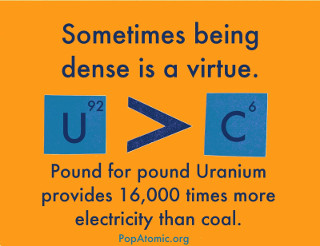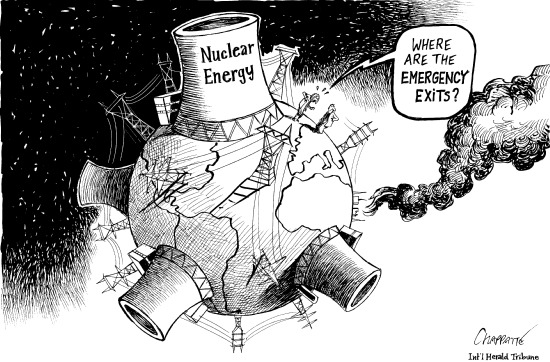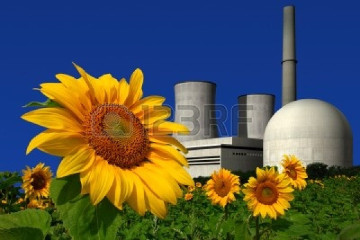"He blinked at the sun and dreamt that perhaps he might snare it and spare it as it went down to its resting place amidst the distant hills."
H.G.Wells, The World Set Free

In the not too distant future, we might as well be able to 'ensnare the Sun' and realise our dream of controlling a power, heretofore only available to the Gods.
Energy unleashed due to fission (splitting of heavy nuclei) and fusion (coalescing of light nuclei,as happens in stars like Sun) as per mass–energy equivalence (energy per unit mass = $c^2$ =VERY LARGE QUANTITY ~$10^{17}$ ) is used to generate steam which turns turbine blades, producing electricity.
Associated concerns are primarily related to safety of people and environment (proper management of radioactive raw materials, proper radioactive waste disposal, control of nuclear weapon technologies etc.), and while development of nuclear fusion technology may do away with radioactive hazard (as reactants and products are non-radioactive) but, the more fundamental concerns yet remain unanswered :
"Man is too frail a being to be entrusted with such power as atomic energy possesses."
-Willian Fanning, NYT
"Horrible as it may be to those who at present are getting the taste of the destruction, we must not forget that we can be boomeranged in just as hellish manner--not from the enemies, but through mistakes in handling the weapon, because many unforeseen, uncalculated reasons."
-Julius Zirinsky, NYT
So, it is not only of Hiroshimas that we have to be wary, but of Fukushimas too.
Strangely indeed, we dare think of 'ensnaring the Sun' while seldom contemplating of leashing our own Cereberaen minds. Bereft of better judgement, great power is weilded by us as proverbial 'sword in ape's hand' and results can be so indescribably horrific as;
"My half burnt body became rotten discharge and it flowed on the bed .I cried 'Kill Me!' over and over again."
A 'survivor' of Nagasaki bombing
and all that 'victors' gain is remorse.
"My God, what have we done?"
diary of Robert A. Lewis, co-pilot of Enola Gay
while, high sounding ideals seem so hollow ...
"It was our hope in developing the bomb that it would be a great force for world cooperation and peace."
Robert R. Wilson, American physicist
While the issues of nuclear warheads can only be checked by self-restaint, reinforced by multipolar checks and balances, the issue of radioactive waste disposal is also as much technological.
Discussions on this topic becomes even more relevant in view of the India–United States Civil Nuclear Agreement signed by the then Indian External Affairs Minister, Pranab Mukherjee and his counterpart, Secretary of State, Condoleezza Rice, on October 10, 2008, which gave great boost to nuclear power programs, earlier hobbled by the UNO enforced regulations. Now, U.S. companies will be allowed to build nuclear reactors in India and provide nuclear fuel for its civilian energy program. In return, India agrees to allow inspectors from the International Atomic Energy Association (IAEA), the United Nations' nuclear watchdog group, access to its civilian (while retaining to determine such reactors as civilian) nuclear program. An approval by the Nuclear Suppliers Group lifting the ban on India has also cleared the way for other countries to make nuclear fuel and technology sales to India.

(COURTSEY : www.globecartoon.com)
Now that Indian State is free to expand its Nuclear Programs at unprecedented rates, atmosphere is rife with concerned voices especially about security concerns and organisations like Greenpeace India vouching for safer energy resources like solar and wind energy. While it is claimed that Indian reactors and nuclear power plants adhere to topmost safety measures and environment safety guidelines, waste disposal is still a much debated topic.
The basic strategy follow in waste disposal is concentrating and containing wastes in isolated environment till radioactivity levels go below accaepted levels and then dispersing them in environment where they get even more diluted. However, this cannot be done for all wastes as some components retain radioactivity for a long time.
In such cases, the only option is that of isolating it by geologic disposal in deep geological formations – under continental crust or under seabed. While many have argued it as best possible and almost foolproof, others have argued about technical uncertainties and lack of knowledge about such long term isolation processes, further unpredictable phenomena like tectonic disturbances are some of many concerns which are raised whenever this topic is discussed.

(COURTSEY:www.123rf.com)
So, while this article is intended to present before you the status quo very briefly; by no means do I intend to opiniate you about the topic. Nuclear Energy resources can be the answer to our problems if aforementioned and still other problems are taken care of and people are working for that. Let us hope it all works out for humanity.

 © Nerd Magazine, IIT Kanpur,2017. All rights reserved.
© Nerd Magazine, IIT Kanpur,2017. All rights reserved.
Comments
comments powered by Disqus